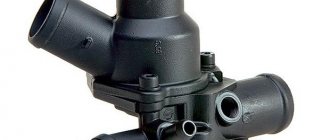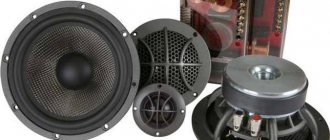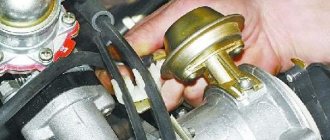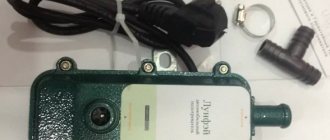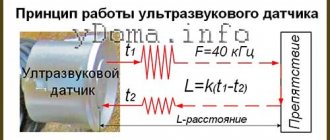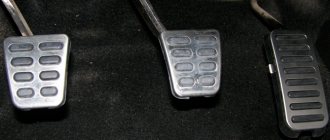Website about joints
Recently, the engine has stopped reaching normal temperature, the maximum limit is 78 - 80 degrees (although according to the passport it should be 85 degrees) Since the thermostat on my car has already been changed once under warranty, I decided not to buy the same one...
The topic is not new, you can take it apart thermostat and install a thermocouple from AUDI into it. Wahler 3091.92D (92 degrees) is ideal for our “thermos”
and
Wahler 3017.87D (87 degrees)
.
I ordered a thermostat on the Exist Wahler 3017.87D. Basically everyone sets it to 92 degrees, but I think in the summer there will be problems...
I received this box. All you need from the thermostat itself is a thermocouple and a spring...
code Luzar LT 0192
OEM number: 2190-1306010-92 2190-1306010 21200-5PA0A 2190-1306100
Opening temperature, ?С: 92
Where can I buy
Applicability for vehicles
Brand name – LT – LuzarThermostat
Thermostats are necessary to direct the flow of coolant in the cooling system of automobile engines, thereby regulating the temperature of the coolant.
- when the temperature rises (usually at ≈80ºC), the main thermostat valve opens while the bypass valve closes;
- the radiator is included in the cooling circuit;
- the coolant temperature drops;
- When the temperature decreases, the reverse process occurs.
If necessary. more details
Brand name – LT – LuzarThermostat
Thermostats are necessary to direct the flow of coolant in the cooling system of automobile engines, thereby regulating the temperature of the coolant.
- when the temperature rises (usually at ≈80ºC), the main thermostat valve opens while the bypass valve closes;
- the radiator is included in the cooling circuit;
- the coolant temperature drops;
- When the temperature decreases, the reverse process occurs.
If you need to purchase a thermostat for a car, you need to know a few simple rules.
The operation of a car thermostat is characterized by two parameters:
The service life of a car thermostat depends on the degree of professionalism of the manufacturer and depends on the following points:
- thermostat designs
- pairing parts
- production technologies
- technical production capabilities
- raw materials used
- level of control of finished products
In turn, the accuracy of the auto thermostat is “revealed” by several indicators:
- opening temperature
- opening speed
- valve lift
- pressure at which the valve seals when closed
Purpose, principle of operation
The main purpose of the cooling system is to maintain a constant temperature so that the engine does not overheat.
An important role is played by the operation of the Lada Vesta 21129 engine thermostat. It is designed to switch from a small to a large circuit. When the thermostat is turned on, a large circuit is connected, where the liquid is cooled due to the counter flow of air passing through the heat exchanger.
A significant role is played by the electric fan installed behind the Vesta radiator. It is controlled by a signal from a sensor that is installed on the motor. When the set temperature is exceeded, a signal is given to turn it on.
The signal is given regardless of the position or presence of the key in the Lada ignition switch. An expansion tank is designed to compensate for the expansion of liquid in the Vesta cooling system. When both circuits operate correctly, the operating temperature of the Lada Vesta engine is maintained.
Design of LUZAR thermostats
The terms should be distinguished:
- thermostat in a broad sense (car part, thermostat in a housing, thermostat as a “function”)
- thermostat in the “commodity” sense (a replaceable part of the thermostat, can be either a thermostat in the housing or a thermoelement; what is sold as a thermostat for a given machine)
- thermoelement (“working” part of the thermostat, in some cases may coincide with the name of the thermostat in the “commodity” sense)
- temperature sensor (the executive part of the thermostat is part of the thermoelement; it is a brass cylinder with a filler that expands when heated)
An automobile thermostat consists of a temperature sensor, which is a brass cylinder with a filler (technical paraffin or thermal wax), which expands when heated, with a rod on which spring-loaded plates of the main and bypass valves are placed; the temperature sensor is rigidly fixed to the frame, through which the thermoelement can be installed in the thermostat housing. The valve discs have rubber seals.
Automotive thermostats can be cased or uncased, depending on the design laid down by the designer of the engine.
Design image
- modern automotive industry, with the increasing complexity of automobile engines, is switching to the use of electronic thermostats, where temperature control is carried out by sensors, and the thermostat valves are controlled by micromotors (LUZAR does not produce electronic thermostats)
- Many modern engines have not one, but two or more thermostats - for non-uniform temperature control in different parts of the engine.
Cooling system composition
The Lada Vesta engine cooling system consists of:
- Engine radiator;
- Pump or CO pump with thermostat;
- Stoves;
- Electric fan;
- A tank designed to expand ethylene glycol;
- Patrubkov.
When cooling, a special liquid is used, a mixture of ethylene glycol and water in a certain proportion. The minimum outside temperature depends on its density. If there is a leak, the driver should know what actions to take in this case.
It is possible to add distilled water, but it is necessary to replace or restore the density of ethylene glycol as soon as possible.
Advantages of LUZAR thermostats
- Computer dosage of thermal wax LUZAR thermostats have thermal sensors filled using special equipment, which guarantees high accuracy of operation.
- Patented thermal sensor design To eliminate the possibility of a “breakthrough” of thermal wax from the thermal sensor body (which, according to statistics, is the most common cause of thermostat failure), LUZAR changed the configuration of the sealing gasket in the rod-thermal wax-cylinder interface. With increasing pressure, which expands when heated, the thermal wax gasket design - thanks to its specific geometry - forms an increased volume of rubber precisely in places where the thermal wax “breakthrough” may occur. This also required changing the geometry of the temperature sensor housing (“cylinder”).
- Rubberized valves We have eliminated the cause of insufficient tightness of the thermoelement - the metal-to-metal interface between the metal frame of the thermoelement and the metal valve plate - by using a rubber sealing gasket on the valve plate. Thus, LUZAR thermostats provide faster engine warm-up in winter (which is so important in Russian conditions climate).
- 100% control of thermoelements Each thermoelement is tested for temperature, height and response speed - carried out in special baths with cells.
- Warranty 2 years or 125,000 km. Mandatory certification In the event of a breakdown, you can easily replace the purchased thermostat through a retail store - just return it with a warranty card and a description of the defect. All products are certified according to the international quality management system ISO 9001 TUV and have GOST-R certificates of conformity.
No. 2 Modification of the thermostat on the Lada Grant - replacement of the thermal insert
This method involves completely dismantling the flow regulator and disassembling it into its component elements. The detailed process is described above.
We troubleshoot the thermostat cavity, wipe it with a rag, and inspect it for cracks and other defects.
Removed spring from thermocouple
We replace the entire “core”. The following cores are suitable for the standard thermostat:
- Wahler: 3017.87 D (at 87°C);
- Behr (Behr) 3091.92V (at 90°C).
We replace the complete set, including the spring, and the modification of the Luzar thermostat on the Lada Grant is completed.
Note to the driver! Such modernization is possible only with thermostats manufactured by BEHR. Products from other companies are incompatible in terms of parameters. Many car owners do not know about these subtleties and end up in ridiculous situations.
As an alternative, use a core from Daewoo or Renault, catalog part number - Vernet 4898.92. The design of the part is somewhat different and requires adjustment. For standard thermostats from Luzar, such an upgrade is not possible.
Subject to the recommendations, fuel consumption will decrease by 1.0 - 1.5% minimum.
No. 3 Modification of the thermostat on the Lada Grant - heating the throttle valve
The throttle valve on the Lada Granta is not heated. In winter, in severe frosts, metal structures slightly grab, which is noticeable while driving a car.
There is only one way to protect the unit from freezing - to run the circuit from the cooling system.
Sequencing
- We place the car on the inspection hole and remove the metal protection of the oil pan.
- Drain the antifreeze.
- We release the clamps - ties, remove the rubber supply and return pipes.
- We dismantle the flow regulator, fix it in a vice, and disassemble it into its component elements.
- In the back of the case we drill an additional hole at “10”.
- Using argon welding, we weld the fitting to the hole for partial intake of antifreeze from the thermostat (Luzar).
- We assemble the structure.
- We put the rubber pipe on the fitting.
- We fill the system with antifreeze.
- We start the engine and test the proper operation of the stove heater.
Note to the driver! In this method of modification, the standard studs must be replaced; the body of the fitting rests against the wall of the block. Replace the studs with new ones, 8 mm in diameter, 10 cm long.
Owner reviews
| № | Positive |
| 1. | Vladimir: I’ve been actively using the car for two years now, and there are no comments about the heating system. I know about the problem of premature valve opening, but for me it is not significant. |
| 2. | Kirill: after 45,000 km I noticed that the regulator opens the valve already at 81°C. I visited a service station, after diagnostics the technician said that the defect was known, but had not yet been corrected by the manufacturer. Comrades recommended shortening the stock rod. |
| 3. | Vitaly: after buying the car, I shortened the regulator rod by 2.0 mm, and the valve activation threshold increased to 87°. This is enough for me, I don’t need to increase it any more. |
| 4. | Dmitry: I knew about the problem of underheating even before buying the car, I prepared in advance. Instead of the standard core, I installed 3091.92 V at 90° C. Now the system works properly. |
| 5. | Gennady: at 80,000 km I replaced the flow regulator for the first time, did not install the original core, bought a Wahler: 3017.87 D. I have been actively using it for two months, no comments. |
| 6. | Alexander: a year has passed since the purchase of the car, the valve opens at 80°C. I know that the threshold is low, but it doesn’t matter to me. I did not notice any increased fuel consumption. |
| 7. | Vasily: after purchasing the car, I replaced the antifreeze with imported one, installed a core from Wahler: 3017.87 D. |
| Negative | |
| 1. | Ivan: The car is a year and a half old, but I can’t fix the problem of early activation of the valve. On the advice of my comrades, I changed the cores, sharpened the stem, nothing helps. |
| 2. | Alexey: extremely dissatisfied with the car, the model is crude, there are many flaws and defects. You constantly need to dig around and fix breakdowns. |
| 3. | Vasily: the thermostat was replaced after a mileage of 50,000 km, after which faults were discovered in the ignition system and so on. |


